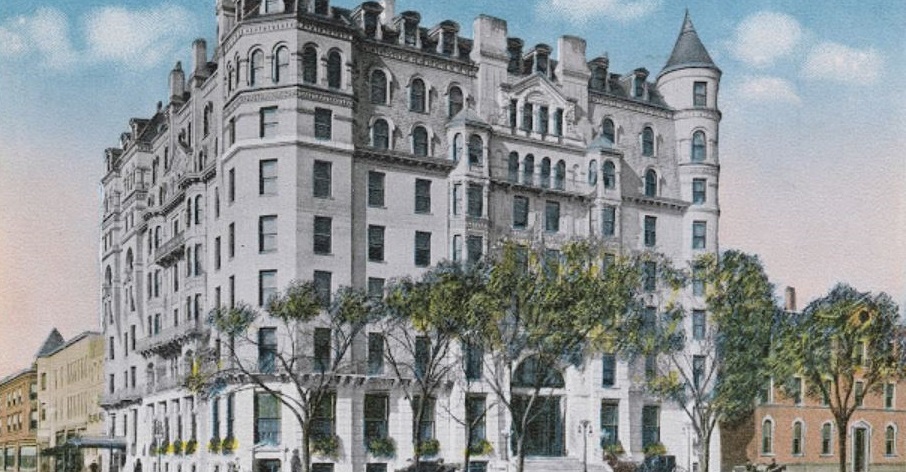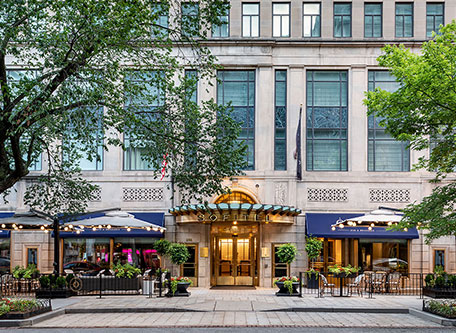Receive for Free - Discover & Explore eNewsletter monthly with advance notice of special offers, packages, and insider savings from 10% - 30% off Best Available Rates at selected hotels.
history
Discover the Sofitel Washington DC Lafayette Square with its classic design including columns and marble floors.
Sofitel Washington DC Lafayette Square, a member of Historic Hotels of America since 2018, dates back to 1925.
VIEW TIMELINEA member of Historic Hotels of America since 2018, the Sofitel Washington DC Lafayette Square is among the most celebrated holiday destinations in the District of Columbia. Its history is also quite extensive, harkening back well over a century. While the current iteration of the building first appeared at the height of the Roaring Twenties, the area had originally been developed during the late 19th century. The very first structure to reside at the intersection of 15th and H streets was the “Shoreham Hotel,” constructed at the behest of Levi P. Morgan, who was then serving as the Vice President of the United States. Named in honor of Morgan’s hometown in northern Vermont, Morgan decided to construct a wonderful boutique hotel as an investment opportunity. (Morgan himself had established his initial fortune through the creation of many upscale apartment complexes throughout the Northeast.) He subsequently hired the renowned architectural firm Herbert, Pirsson & Company to oversee its beautiful design, which had specialized in developing countless high-rises skyscrapers. Taking several months to complete, the building finally debuted in 1887 with some of the finest Classical Revival-style architecture in Washington. It quickly became a popular destination among travelers arriving in the nation’s capital over the next two decades, inspiring Morgan to expand the building several more times. Some of the most impressive work that Morgan commissioned was to the hotel’s stunning dining hall, with its onyx wainscotting and golden-hued walls. The great architect Waddy Butler Wood even oversaw a massive expansion of the building in 1913, earning the praise of The Washington Post and a few other local newspapers. In fact, President-Elect Woodrow Wilson though the structure’s new additions so fantastic that he spent most of his time before his inauguration at the Shoreham Hotel.
The dawn of the 20th century constituted the pinnacle of the Shoreham Hotel’s success, though as its fortunes began to decline considerably in the years that followed World War I. Interest in visiting the hotel had practically dissolved by the 1920s, forcing the hotel’s ownership group to declare bankruptcy right before the onset of the Great Depression. The building subsequently went to public auction, with the great real estate developer, Harry Wardman, ultimately purchasing it outright. While many in Washington regarded Wardman as a builder of great rowhouses and apartment complexes, he had also received acclaim for his work on such renowned hotels like the Wardman Park Hotel, the Carlton Hotel, and the Hay-Adams Hotel. Wardman had planned to reopen the Shoreham Hotel, too, but opted to transform the site into a brilliant office building instead. He soon tasked his construction company’s lead architect, Mihran Mesrobian, to reconfigure the structure’s interior to resemble the layout of a modern commercial business space. Yet, the more Mesrobian altered the erstwhile hotel’s appearance, the more he determined that a completely new structure was necessary. After months of planning, Mesrobian encouraged Wardman to demolish the Shoreham Hotel in 1928. Construction on the new “Shoreham Building” commenced immediately thereafter, with Mesrobian using a blend of Renaissance Revival design aesthetics to create its magnificent façade. Wardman and Mesrobian’s amazing multistory structure debuted a year later and continued to operate as an office building for the next 70 years. (Meanwhile, construction on the new Shoreham Hotel along Connecticut Avenue began around the same time. Today, its known as the “Omni Shoreham Hotel” and is also a member of Historic Hotels of America.)
In 1999, AccorHotels acquired the building and subjected it to its own series of renovations that sought to greatly rehabilitate its spectacular historical character. The project was incredibly extensive, with the project lasting three years in total. When the hotel reopened as the “Sofitel Washington DC Lafayette Square,” it won the praise of people from all over Washington. The Sofitel Washington DC Lafayette Square quickly reestablished itself as one of the city’s premier retreats, building a new reputation for its unrivaled, French-inspired hospitality. Its popularity had surged to such new heights that AccorHotels decided to renovate the structure again in both 2014 and 2015. The hotel now features luxury accommodations with distinctive style and incomparable service. Guests can expect fine dining on-site or eat in with 24-hour room service. Those seeking to hold an event can do so in one of the versatile meeting rooms or celebrate a glamorous wedding in the Paris Ballroom, complete with authentic French cuisine. And no one has to miss a workout with the 24-hour fitness center and all business needs can be met in the business center. Sofitel Washington DC Lafayette Square was even listed in Travel + Leisure's “The Top 10 Hotels in Washington, DC” and inducted into Historic Hotels of America in 2018. Today, this historic hotel remains an exemplary of opulence in the heart of Washington, D.C. It still reflects the rich heritage of the area, conveying luxury and grandiosity that encourages guests to admire its breathtaking beauty.
-
About the Location +
The Sofitel Washington DC Lafayette Square resides within the Fifteenth Street Financial Historic District, which was once the financial heart of Washington throughout the 19th and early 20th centuries. In fact, many of the buildings that originally resided in the area were banks, with some of the earliest founded in the 1820s and 1830s. The greatest of those banks to ever open was a branch of the Second Bank of the United States, inhabiting a structure at the juncture of 15th Street and Pennsylvania Avenue before its closure by President Andrew Jackson in 1836. The firm Corcoran and Riggs occupied the building thereafter and reorganized as the famous Riggs National Bank several decades later. It subsequently constructed a new bank headquarters further up the road in 1898, outfitting it with the finest Classical Revival-style architecture. Other prominent banks opened for business at the height of the Gilded Age, including the National Metropolitan Bank, the First American Bank, American Security Bank, and the National Savings and Trust Company. But most of the financial institutions that had begun operating in the neighborhood were community oriented, since the region’s lack of commercial trade connections had deterred national investment. Nevertheless, those financial institutions spurred Washington’s growth for years, helping it morph into the sprawling international city it is today. They also developed many magnificent structures that showcased some of the best architecture in the whole city. Some of the best architectural minds in the nation worked on the new structures, too, including the likes of Daniel H. Burnham, J.H. de Sibour, John Merven Carrère, and Thomas Hastings. All students of the celebrated École des Beaux-Arts in Paris, they proceeded to erect a number of outstanding skyscrapers created with a combination of Classical Revival and Beaux-Arts-themed architecture.
Yet, the Sofitel Washington DC Lafayette Square is also right next to the illustrious Lafayette Square Historic District. Anchored by the eponymous Lafayette Square, this famous neighborhood is home to such historical landmarks like the Blair House, the Decatur House, and the Eisenhower Executive Office Building. Lafayette Square is just a short walk from additional iconic locations, too, like the White House, The Ellipse, and the National Mall. In the words of the U.S. Department of the Interior: “Its statues remind visitors of the struggle to achieve a popular form of government, and it has often been a meeting place for those wishing to bring important issues to the immediate attention of the Chief Executive.” The destination first came into existence at the start of the 1800s, when laborers began developing the District of Columbia based on the plans of Pierre Charles L’Enfant. Originally destined to serve as an exclusive pleasure garden called “President’s Park,” Thomas Jefferson eventually authorized its construction as a public park to be enjoyed by everyone. But construction did not fully commence until after the Marquis de Lafayette’s visit in 1824. (American politicians later named the area after the French diplomat, settling on the title “Lafayette Square.”) But the first actual landscaping took place some three decades later, when prominent architect Andrew Jackson Downing sculpted the nucleus of its current appearance. Amazingly, Downing’s layout has remained mostly the same, with just minor alterations transpiring in the 1870s, 1930s, and 1960s. Lafayette Square today is among the city’s most noteworthy destinations, as it hosts thousands of visitors from all over the world every year.
-
About the Architecture +
Renowned Armenian-American architect Mihran Mesrobian designed the Sofitel Washington DC Lafayette Square back when it was the Shoreham Building in the late 1920s. Originally a subject of the Ottoman Empire, he had received an education in architecture at the esteemed Ecole des Beaux Arts in Istanbul. Mesrobian’s talents soon earned him admirers across Asia Minor, which eventually brought him to the court of the last Ottoman sultan, Mehmed V. Nevertheless, Mesrobian was drafted into the Ottoman military when World War I erupted in 1914, serving in both the Gallipoli and Caucuses Campaigns. He was eventually captured during the Arab Revolt, although the legendary Lawrence of Arabia secured his release. Upon gaining his freedom, Mesrobian learned of his family’s demise amid the Armenian Genocide. Seeking a new lease on life, Mesrobian immigrated to the United States in 1921, where he earned a position as the lead architect in the construction firm of Harry Wardman. And just like his time in the Ottoman Empire, Mesrobian soon developed a strong reputation throughout the District of Columbia for his architectural designs. He subsequently created the appearance for many noteworthy structures across the city, including Sedgwick Gardens, Calvert Manor, the Hays-Adams Hotel, and The Carlton Hotel. But while of Mesrobian’s work in America reflected the emerging trends of the Art Deco design movement, some of his designs—including the Shoreham Building—displayed variations of Renaissance Revival-style principles.
Renaissance Revival-style architecture itself is among the most ubiquitous in America. Sometimes referred to as “Neo-Renaissance,” Renaissance Revival architecture is a group of architecture revival styles that date back to the 19th century. Neither Grecian nor Gothic in their appearance, Renaissance Revival-style architecture drew inspiration from a wide range of structural motifs found throughout Early Modern Western Europe. Architects in France and Italy were the first to embrace the artistic movement, who saw the architectural forms of the European Renaissance as an opportunity to reinvigorate a sense of civic pride throughout their communities. As such, those intellectuals incorporated the colonnades and low-pitched roofs of Renaissance-era buildings, with the characteristics of Mannerist and Baroque-themed architecture. Perhaps the greatest structural component to a Renaissance Revival-style building involved the installation of a grand staircase in a vein similar to those located at the Château de Blois and the Château de Chambord. This particular feature served as a central focal point for the design, often directing guests to a magnificent lobby or exterior courtyard. Yet, the nebulous nature of Renaissance Revival architecture meant that its appearance varied widely across Europe and North America. Many architects left their own mark upon any structure designed with Renaissance Revival-style design aesthetics, including the great Mihran Mesrobian. Historians, thus, often find it difficult to provide a specific definition for the architectural movement.































